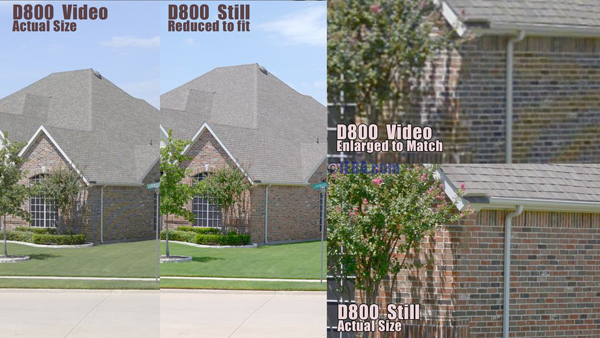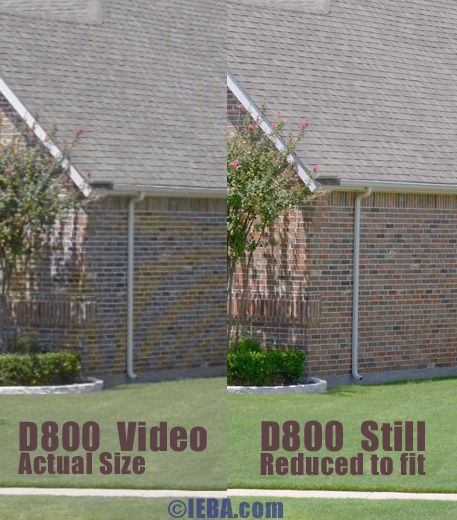Review: Nikon D800 DSLR, Part 2: Usability and Image Quality
In Part 1 of this two-part series on the Nikon D800, I looked at the operation and functionality of the D800 DSLR as a video camera. Now, in Part 2, I'll share some usability notes, as report the results of some audio and video tests (with test footage) comparing the D800 to another highly regarded DSLR, the Panasonic GH2--to see if a lower-priced but very capable DSLR can measure up with quality glass--and to a more traditional prosumer camcorder.
Sharpness and Moire
With all the heat DSLRs have taken for moire and aliasing over the years, I expected the D800 to have this old problem licked. A simple test shooting a house with roof shingles and a brick wall, while slowly zooming out and hand-holding the cameras (to keep the image moving) produced easily visible moire in the D800 video. Both clips were shot at 1080p24 at stock in-camera data rates, Nikon on Standard profile (unchanged), GH2 on Nostalgic (-1, -2, 0, -2). Both clips you see in the video below are ungraded.
The sharpness edge clearly goes to the GH2--especially considering that I dialed down the stock sharpness by two (as far as it can go) and the kit 14-140 zoom lens is acceptable glass, but definitely not the sharpest lens the GH2 can use. I get the same “mostly sharp: results when I shoot photos with the GH2. Comparitively, the still images from the D800 using this same lens are freakishly sharp. So the detail is lost in the D800’s video processing.
Figure 5 (below) shows a composite image of the same house. The 2 MP 1080p24 image is compared to a “Medium” resolution, 20.3 MP still image from the D800. I stopped taking “Large” 36.2 MP stills because they are just so huge. I don't need all that resolution. So the “Actual Size” part of the still image is downsampled in camera from 36 MP to 20 MP and still not a “pixel-for-pixel” representation of all that the camera can do.

Figure 5. You can see how the D800 detail is much greater in stills than in video.
Now, it's obvious that the 2 MP HD image blown up to match the still image is not a fair comparison, but looking at the still image downsampled to the HD video frame size (Figure 6, below) clearly shows that a lot of detail is lost compared to what the camera is taking in. The lens is certainly providing plenty of detail to the sensor. The loss is happening later, in the processing. Putting a better lens on here will probably not change the sharpness of the video.

Figure 6. In this 1:1 image, HD video versus downsampled still image.
A Key Caveat
In performing these tests, I wanted to shoot video with the D800 in Shutter Priority mode, where I could lock the Shutter and ISO and the aperture would ramp up or down automatically depending on the brightness of the scene. Unfortunately, I found that on the D800, Shutter Priority is disabled in video mode. It seems to operate correctly until you press the Live View button, and then the camera takes over.
I asked Nikon about this and their response was as follows:
Shutter priority mode it is not recommended during Live View for Movies. Most videographers use manual mode so that they can control all aspects of exposure; shutter speed/aperture/ISO. Some use Aperture priority but they have to use Exposure Lock to maintain exposure as the camera is panned up/down or left/right.
Nikon’s recommendations from the user’s manual (page 60):
• Manual Mode: To control shutter speed, aperture and ISO
• Aperture priority: To control aperture: I recommend AE-Lock/Hold to lock exposure
• When using Shutter Priority, the camera will operate as though it is in the Program Mode -- the camera controls shutter speed/aperture/ISO
I do not understand why the camera has the limitation. But it does and it’s an important one to note.
Minor Issues with the D800
The charger for the D800 is a little box that plugs directly into an AC outlet and charges the Lithium-ion battery fairly quickly. It's a solid, basic piece of kit, so I hate to nitpick, but several times I walked by the charger, waiting for it to be done, when it was already done. The yellow blinking light merely goes “solid” and stays on when the battery is charged. A 2-color LED that changed to green when the battery is charged would be a lot more definitive.
Moreover, in an age when all kinds of chargers have “fold down” prongs to make them easier to carry when traveling, the Nikon charger has an oversized housing for the prongs that can either point up from the top of the charger, or rotate to the back, but they cannot fold away. So they are always sticking out somewhere. I don’t see why it couldn’t have been the same fold-away design as is used on so many other consumer electronics.
White balance has been a simple affair on camcorders for decades. Point at a white sheet of paper, hit a button. You're telling the camera that what it’s pointing at is white, so it should adjust accordingly. There's nothing like that on a DSLR. Moreover, if you’re dealing with different lenses, or older glass which may have a color cast you’re looking to correct for, you will need to enter the manual color matrix and push a dot around a four-way grid to manually correct for color. Unfortunately, when you do this on the D800, you are in a menu and you can't see the image. So every adjustment is a guess till you go back to the shot. Then it’s an annoying back-and-forth process. Then you have to ask yourself, is the LCD you are using to assess the shot color-accurate? What's the color temperature of the backlighting? This is why telling the camera to "make it white" is a far better solution.
You never consider how important a tilt-swivel camcorder screen is to the easy operation of a camera until you don't have one. The tilt-swivel screen was one of the primary factors in my deciding to buy a GH2. In 20+ years, I have never used a video camera that didn’t either have a viewfinder that could tilt up and down, or an LCD screen that could do even more. Adapting to use a DSLR with a fixed, flat, reflective screen on the back is a challenge in and of itself. Be prepared to adapt, or be prepared to buy and rig up an external monitor or external viewfinder to make DSLR use a heck of a lot easier.
Related Articles
In the P7700, Nikon has improved on earlier P7000 models with numerous video formats and a microphone input, plus a tilt-swivel display and several under-the-hood improvements. Is this the video-and-stills powerhouse I've been waiting for?
D7100 features 24.1 megapixel CMOS sensor, 51 focus points including 15 cross-type sensors, 100-6400 ISO range, and new WU-1a wireless mobile adapter
In this two-part series, we'll examine how well Nikon's much-heralded D800 DSLR works as a video camera, in terms of operability and functionality. In part two, we'll report on some audio and video tests comparing the D800 to another highly regarded DSLR, and to a more traditional prosumer camcorder.